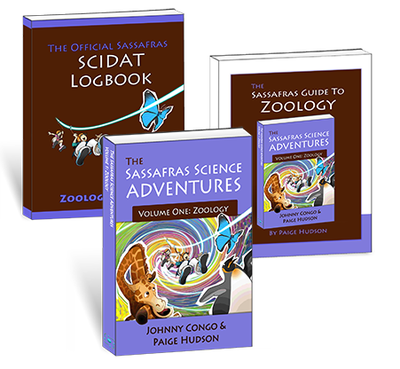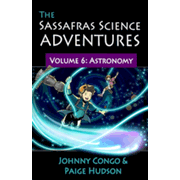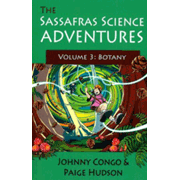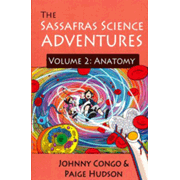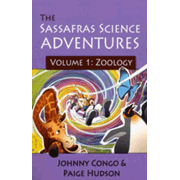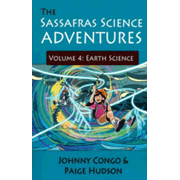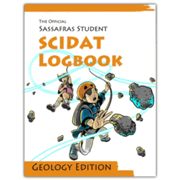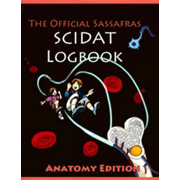Elemental Science publishes two different science series for the elementary grades. I review the Classic series separately. The Sassafras Science Adventures series, which I review here, has six courses that are each based on a science-themed novel:
- Volume 1: Zoology
- Volume 2: Anatomy
- Volume 3: Botany
- Volume 4: Earth Science
- Volume 5: Geology
- Volume 6: Astronomy
These courses use elements of both unit study and Charlotte Mason's methodology since they include elements such as stories, copywork, and hands-on activities, with all of these relating to central science themes.
Written for kindergarten through fifth grade, each course takes one semester to complete. So you can complete two courses per year.
For each course, there are four potential components to choose from that are published by Elemental Science: The Sassafras Science Adventures - the adventure novel that serves as your spine, a Sassafras guide (teacher guide), The Official Sassafras SCIDAT Logbook (for data recording and notebooking), and a lapbooking guide (with instructions and templates for creating a lapbook).
Which components you use will depend on the ages of your students and personal preference. A Sassafras adventure novel is the heart of each course no matter which of the other options you select. I have read only the first one, and it is fairly well written and might be used on its own apart from the course. In the first book, twins Blaine and Tracey set off on worldwide adventures where they learn about animals and their habitats. Other books continue with the twins' adventures. Magical, invisible zip lines and crazy Uncle Cecil, a research scientist, help provide an intriguing storyline.
In addition to the adventure novel, you need to choose between the lapbooking guide and the Sassafras guide. The lapbooking guide has fewer activities and seems a better fit for younger children while the Sassafras guide seems a better fit for older students. However, older students who thrive on the notebooking/lapbooking approach might still prefer the format of the lapbooking guide. Both options include reading assignments in the adventure novel, science demonstrations, recommendations for other books to read, and vocabulary study. Vocabulary work differs in the two options. The lapbooking guide has preprinted vocabulary words and definitions, while the Sassafras guide directs students to enter words and definitions in the glossary they will create. Lapbooks provide templates for students to construct their own mini-books which they then fill with brief written or dictated summaries of what they have learned. An optional lab report form is included. Also, the lapbooking guide is narrowly focused on only eight lessons (about half of the total lessons), stretching out activities for each of those lessons for two weeks.
The Sassafras guide for the parent provides for each lesson a chapter summary of the story from the adventure novel, reading assignments from recommended resource books, the information that students are to be entering into the SCIDAT Logbook, instructions and materials lists for experiments, vocabulary words and their definitions, a short copywork passage, a longer dictation passage, suggested schedules, a quiz, and additional activities. Additional activities include options such as art projects, recipes, and physical activities, as well as multi-week projects such as creating a food chart for various animal groups or creating a habitat project. Following instructions in the guide, you might also have students do copywork do oral or written narrations about what they have learned. Parents need to select which activities to use for their children rather than requiring them to complete all of them, since the plentitude of activities is provided to meet the needs of students of different ages and with different learning styles. At the end of the guide are reproducible pages for the student glossary, an experiment report form, and other items such as small animal pictures to be cut and pasted into the SCIDAT Logbook.
The guide's lesson plans for each chapter include options for either two days or five days per week. The two-day schedule covers chapters at the same pace as the five-day schedule, but it omits some activities. A number of resource books—many of which are fact or information books that you can get from the library—are recommended for each chapter, and you are free to select whichever ones you like.
The Sassafras guides include the use of other books for some of the essential reading. For example, for the Sassafras Guide to Zoology, you will probably use Kingfisher's First Encyclopedia of Animals if you are teaching students in kindergarten through third grade and/or the DK Encyclopedia of Animals for students in grades three through five.
The SCIDAT Logbook should be used along with the Sassafras guide with students who are able to write well enough to record information. Students could create their own notebooks instead of using the SCIDAT Logbook, but that requires much more effort. While kindergartners and first graders can draw and copy in the SCIDAT Logbook, they might not be ready to do as much writing as older students. They might do better creating their own lapbook or smaller notebook.
Whichever Sassafras option you select, parents need to gather resources (books and experiment supplies). Parents will also need to dedicate time for the courses for things such as reading aloud some of the books, listening to narrations, and providing dictation. While all of this requires a time commitment, the guides are so well organized that they make it fairly simple to direct the various learning activities. To make things even simpler, the publisher sells bundles for year-long courses covering two of the adventure novels. The bundles include the three main books for each volume along with the items you need for experiments.
The adventure novels are available as print, audiobook, PDF, and Kindle editions. Other items are available in your choice of PDF or printed versions. See the publisher's website for all of your options. The lapbooking guides and bundles with experiment resources are available only from the publisher.
As I mentioned near the beginning of the review, the Sassafras Science courses have elements of Charlotte Mason's methodology, but they aren't strictly Charlotte Mason. They tend to be more directive as to what children are to record than in a total Charlotte Mason approach. Students are sometimes given particular information through the adventure novels and assignments for the SCIDAT Logbook and for lapbooking, and that is what they are expected to learn. Charlotte Mason would more likely have students observe, draw what they see, and come up with their own information from their books and observations. Nevertheless, this approach of guided learning from novels along with the creation of the SCIDAT Logbook or a lapbook offers an interesting way to learn science and allows you to teach all of your children in the elementary grades together.





